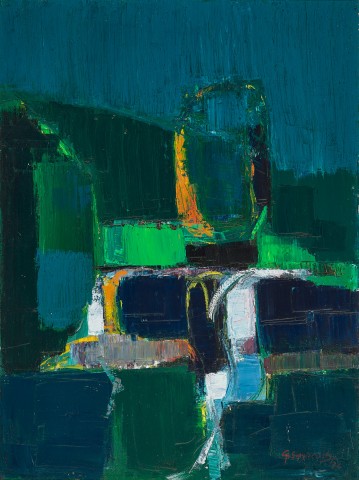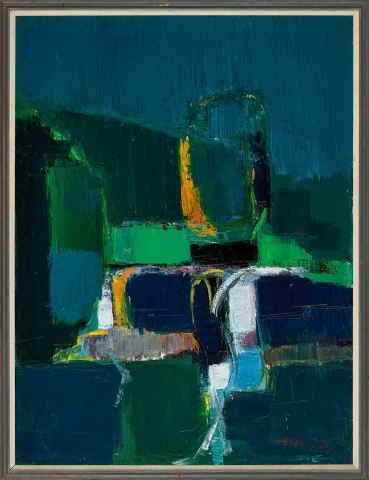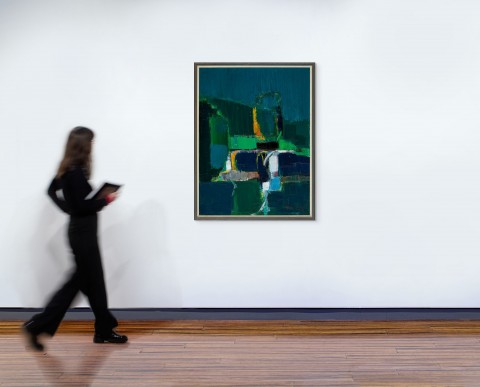CASCADES, 1976
GUY GREY-SMITH
oil and beeswax emulsion on gauze on composition board
120.0 x 90.0 cm
signed and dated lower right: G. Grey Smith / 76
bears inscription verso: Guy GREY–SMITH “Cascades”
Greenhill Galleries, Adelaide
Private collection, Melbourne, acquired from the above in 1977
Private collection, Melbourne, a gift from the above in 2018
Ten Western Australian Artists, The Western Australian Art Gallery, Perth, 18 August – 26 September 1976, cat. 2 (illus. in exhibition catalogue)
Guy Grey-Smith, Greenhill Galleries, Adelaide, opened 11 September 1977, cat. 12 (as 'Cascade')
Guy Grey-Smith had an emotional attachment to the landscape of Western Australia, with an intensity that was directly transferred to his paintings. As with many who have walked those lands, this connection was also spiritual, even transformative, and for a man whose soul had been so damaged by his experiences during World War Two and then Cambodia in the late 1960s, the dense karri forests of the state’s south-west, where Cascades, 1976, was painted, were particularly healing. He and his wife, the artist Helen Grey-Smith, moved there in 1974 when the encroach of suburbia and a constant stream of visitors made their previous home in the Darling Ranges outside Perth less of the haven that it had been; and the purchase of a small wood-cutters cottage in the timber town of Pemberton ‘suited the two self-described ‘country personalities’ perfectly.’1
Cascades dates from the same year as Grey-Smith’s extensive and acclaimed retrospective was held at the Art Gallery of Western Australia in November 1976, which then toured to Queensland the following year. Although it was not in that show, Cascades was exhibited at the AGWA some months previously in the exhibition Ten Western Australian Artists which is credited as being a moment when the Gallery had ‘finally come out in favour of local art,’2 the retrospective being their next clear statement of intent. By chronologically surveying Grey-Smith’s works from 1945 to 1976, the retrospective allowed viewers to follow his evolving technique from his early days as a patient receiving art therapy in a sanitorium treating him for tuberculosis contracted after four years as a prisoner-of-war followed by study at the Chelsea School of Arts on recovery. By the late 1950s, his painting, ceramics and fresco skills all began to coalesce into masterworks such as Horseshoe Range, 1958 – 61 (Art Gallery of Western Australia) which contained clear indications as to why his subsequent discovery of the work of Nicolas de Staël became so inspirational. By using scrapers and trowels, combined with paint bulked up by a home-made wax medium, Grey-Smith’s paintings were now tectonic expressions of the very essence – the ‘life force’ – of the subjects in front of him. He was no longer a plein air painter and would instead travel extensively through Western Australia, sketching as he went, before returning to the studio to create painterly reimaginings. In the late 1960s, as a result of journeys to Sri Lanka and Bali, he reintroduced the brush which allowed for fluid curves and arcs to counterbalance the planes of slab-paint.
Grey-Smith was appointed Professor of Fine Art at Phnom Penh University in 1969, which tragically coincided with the outbreak of war. He suffered a total nervous collapse as a result which incapacitated him for an extended period, but by 1974 and the move to Pemberton, optimism had returned to his work. The cascades featured in the painting are on the Warren River, not far from the Pemberton cottage, and Grey-Smith perfectly captures the ‘evocative … visual experience of moving between light and dark, so common in a thickly wooded place, and firmly makes the viewer part of the scene.’3 The counterplay of deep blues and striking emerald-green, orange and bruised purple, demonstrates Grey-Smith’s mastery of colour and clearly invokes his deeply emotional reaction to the scene.
1. Gaynor, A., Guy Grey-Smith: life force, University of Western Australia, Perth, 2012, p. 92
2. Cruthers, J., ‘Visual Arts: the gallery scene and a retrospective’, Westerly, Perth, no. 4, December 1976, p. 122
3. Harpley, M., Guy Grey-Smith: art as life, Art Gallery of Western Australia, Perth, 2014, p. 14
ANDREW GAYNOR


